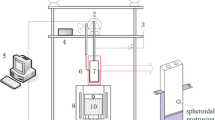Abstract
Axial heat-flux profiles have been determined quantitatively from temperature measurements conducted on a slab mold under routine operating conditions. As in earlier studies, the heat flux was observed to have a maximum value at the meniscus and to decline with increasing distance down the mold. The mold heat flux increased with increasing casting speed and was greater with a mold powder having lower viscosity and melting point being applied as lubricant. The heat extraction was largest while casting 0.29 pet carbon steel and least for a 0.09 pet carbon grade; reducing the depth of the submerged entry nozzle increased the heat flux slightly in the upper region of the mold. Most significant was the higher heat flux observed at the meniscus of the outside-radius face, attributable to the locally greater copper plate thickness compared to that of the opposite broad face. All of the measurements can be explained straightforwardly by heat flow in the vicinity of the meniscus and the resulting behavior of the so-called slag rim adjacent to the mold wall. It is postulated that the difference in copper plate thickness between the two broad faces at the meniscus causes the slag rim to be smaller on the outside-radius face which gives rise to shallower oscillation marks, as observed, higher heat transfer, and a slightly thicker solid shell. The dissimilar behavior has implications for quality because the inside-radius shell, experiencing reduced heat extraction, cools and shrinks less than the outside-radius shell. Thus, for a given end-plate taper, the narrow face of the slab adjacent to the inside radius can push against the end plate, accelerating copper wear, and, owing to squeezing of the broad face, cause an off-corner depression and subsurface crack toward the mold exit. If this is correct, maintenance of the same copper plate thickness at the meniscus is fundamental to preventing such an occurrence. Moreover, adjustment of the heat extraction at the meniscus should be achievable by changing copper plate thickness, mold coating thickness/conductivity, cooling water velocity, cooling channel configuration, and mold flux composition for a given steel grade.
Similar content being viewed by others
References
S. Watanabe, K. Harada, N. Fujita, Y. Tamura, and K. Noro:Tetsu-to-Hagane, 1972, vol. 58(H), PP. 393–94.
R. Scheel, H. Stahl, A.G. Dortmund, and W. Korte:Stahl Eisen, 1988, vol. 107 (17), pp. 781–87.
T. Emi, H. Nakato, Y. Iida, K. Emota, R. Tachibana, T. Imai, and H. Bada:Steelmaking Conf. Proc., Iron and Steel Society, Warrendale, PA, 1978, vol. 61, pp. 350–61.
M. Wolf:Trans. Iron Steel Inst. Jpn., 1980, vol. 20, pp. 710–17.
A.M. Pozhivanov, V.I. Dozhdikov, V.M. Kukartsev, V.P. Farafonov, I.I. Sheinfel’d, and V.E. Berezhanskii:Steel USSR, 1986, vol. 16, pp. 324–25.
E.L. Fogleman and R.T. One:J. Met., 1974, vol. 26, (10), pp. 37–42.
E. Takeuchi and J.K. Brimacombe:Metall. Trans. B, 1985, vol. 16B, pp. 605–24.
E. Takeuchi and J.K. Brimacombe:Metall. Trans. B, 1984, vol. 15B, pp. 493–509.
K. Kawakami, T. Kitagawa, M. Komatsu, H. Mizukami, A. Mausi, and T. Ishida: Nippon Kokan Technical Report Overseas, 1982, no. 36, pp. 1–9.
A.W. Cramb and F.J. Manion:Steelmaking Conf. Proc., Iron and Steel Society, Warrendale, PA, 1985, vol. 68, pp. 349–59.
K. Tada, J.P. Birat, P. Riboud, M. Larrecq, and H. Hackl:Tetsu-to-Hagane, 1984, vol. 70, p. 155.
J.K. Brimacombe, F. Weinberg, and E.B. Hawbolt:Metall. Trans. B, 1979, vol. 10B, pp. 279–92.
W.R. Iving, A. Perkins, and R. Gray:Ironmaking and Steel-making, 1984, vol. 11 (3), pp. 146–51.
S. Farkas, J.W. Shaw, and J.D. Gricol:Open Hearth Conf. Proc, Iron and Steel Society, Warrendale, PA, 1971, vol. 54, pp.68–80.
A. Delahalle, J.F. Moriotton, J.P. Birat, J. Foussal, M. Larrecq, and G. Tourscheo:Steelmaking Conf. Proc, Iron and Steel Society, Warrendale, PA, 1984, vol. 67, pp. 21–35.
A. Byrne, J. Powell, A. Perkins, and N. Hunter:Proc. 4th Int. Conf. on Continuous Casting, Centre de Recherches Metallurgiques, Brussels and Verein Deutscher Eisenhuttenleute, Dusseldorf, eds., Verlag Stahleisen mbH, Dusseldorf, Brussels, 1988, pp. 177–88.
W.R. Storkman and B.G. Thomas:Modeling of Casting and Welding Processes, Engineering Foundation Center, Palm Coast, FL, April 17-22, 1988.
R.V. Branion:Iron Steelmaker, 1986, vol. 13 (9), pp. 41–50.
I.V. Samarasekera, J.K. Brimacombe, and R. Bommaraju:Iron Steel Soc. Trans., 1984, vol. 5, pp. 79–94.
H. Kyoden, T. Doihara, and O. Nomura:Steelmaking Conf. Proc., Iron and Steel Society, Warrendale, PA, 1986, vol. 69, pp. 153–59.
S.N. Singh and K.E. Blazek:Open Hearth Proc., Iron and Steel Society, Warrendale, PA, 1976, vol. 59, pp. 264–83.
A. Grill and J.K. Brimacombe:Ironmaking and Steelmaking, 1976, no. 2, pp. 76–79.
M.R. Bridge and G.D. Rogers:Metall. Trans. B, 1984, vol. 15B, pp. 581–89.
H. Yamamoto, Y. Nuri, and T. Ohashi:Trans. Iron Steel Inst. Jpn., 1982, vol. 22, p. B-336.
I.A. Bakshi, E. Osinski, I.V. Samarasekera, and J.K. Brimacombe:Proc. Int. Symp. on Direct Rolling and Hot Charging of Strand Cast Billets, Canadian Institute of Mining and Metallurgy, Montreal, 1988, pp. 60–69.
P.V. Riboud and M. Larrecq:Steelmaking Conf. Proc., Iron and Steel Society, Warrendale, PA, 1979, vol. 62, pp. 78–92.
S. Ohmiya, K.H. Tacke, and K. Schwerdtfeger:Ironmaking and Steelmaking, 1983, vol. 10 (1), pp. 24–30.
A. Delhalle, M. Larrecq, J. Petegnief, and J.P. Radot:Proc. 4th Int. Conf. on Continuous Casting, Centre de Recherches Metallurgiques, Brussels and Verein Deutscher Eisenhuttenleute, Dusseldorf, eds., Verlag Stahleisen mbH, Dusseldorf, Brussels, 1988, pp. 38–48.
J.D. Young: Stelco Steel Ltd., Hamilton, Ontario, private communication, 1990.
N. A. McPherson and R.E. Mercer:Ironmaking and Steelmaking, 1980, vol. 7, pp. 167–79.
R.B. Mahapatra, J.K. Brimacombe, I.V. Samarasekera, and N. Walker:Metall. Trans. B, 1991, vol. 22B, pp. 861–74.
Author information
Authors and Affiliations
Additional information
Formerly Graduate Student, Centre for Metallurgical Process Engineering, The University of British Columbia,
Rights and permissions
About this article
Cite this article
Mahapatra, R.B., Brimacombe, J.K. & Samarasekera, I.V. Mold behavior and its influence on quality in the continuous casting of steel slabs: Part II. Mold heat transfer, mold flux behavior, formation of oscillation marks, longitudinal off-corner depressions, and subsurface cracks. Metall Trans B 22, 875–888 (1991). https://doi.org/10.1007/BF02651164
Received:
Published:
Issue Date:
DOI: https://doi.org/10.1007/BF02651164



